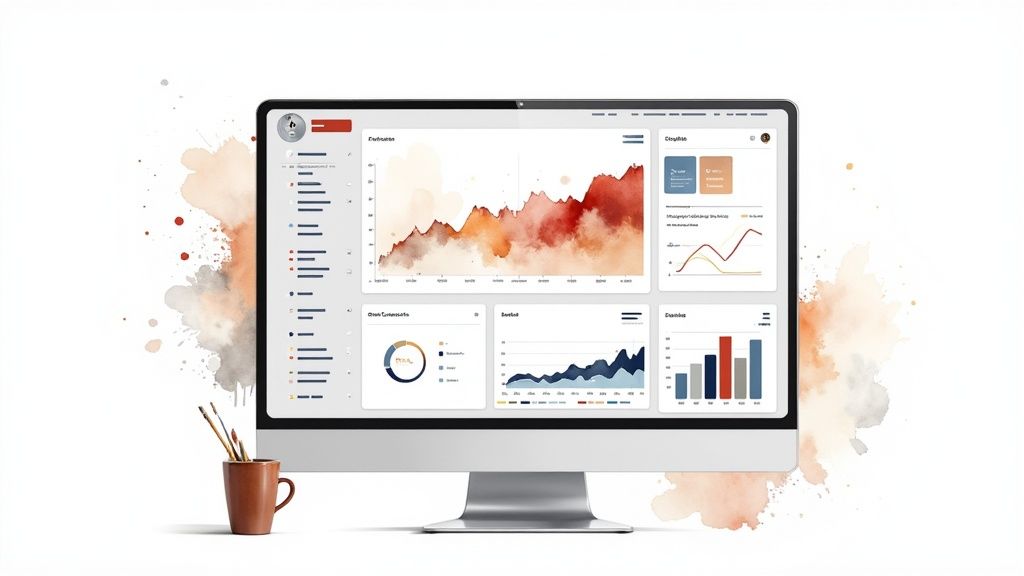



Sentiment analysis has evolved. It's no longer simply about identifying positive or negative words. Modern sentiment scores measure the intensity and nuance of emotions in text, providing data for better decision-making. This sophisticated analysis helps businesses understand not just what customers feel, but how strongly they feel it, delving into the "why" behind opinions.
Different scoring scales exist. Some use a simple -1 to +1 scale: -1 is most negative, 0 is neutral, and +1 is most positive. Others use more granular scales, like -100 to +100, for greater precision. Choosing the right scale depends on your needs. A -1 to +1 scale might be enough for broad analysis, while a more granular scale may be necessary for detailed market research.
Calculating a sentiment score transforms raw text into quantifiable data, bridging subjective expression and objective metrics. This transformation, using Natural Language Processing (NLP) techniques and machine learning models, is key for data-driven insights. For example, AlphaSense uses machine learning to score the tone of transcripts from -100 to 100, with zero being neutral. Their models analyze each sentence, predicting its sentiment (positive, negative, or neutral) with a confidence value. The score is then normalized across documents for standardized comparison. This is particularly useful for analyzing earnings calls to gauge sentiment shifts, potentially indicating market movements. Explore this topic further.
Advanced sentiment analysis tools are improving at understanding context and nuance, including sarcasm and irony. They can also track subtle sentiment shifts over time, revealing evolving trends and opinions. This depth is valuable for fast-paced industries like cryptocurrency, where accurate sentiment analysis can be a competitive advantage.

These advancements help businesses make data-driven decisions, improve customer experiences, and gain a competitive edge. They allow companies to provide more accurate and actionable insights. As sentiment analysis evolves, its impact on business strategies will only increase.
For those unfamiliar with data science, calculating sentiment scores can feel like a significant hurdle. However, several accessible methods bypass the need for coding entirely. These no-code approaches empower anyone to delve into text data and uncover meaningful insights. This section will explore practical and effective ways to calculate sentiment scores without writing a single line of code.
One prevalent no-code method relies on lexicon-based approaches. Lexicons are essentially dictionaries assigning sentiment values to words. For example, "excellent" might be assigned a +2, "good" a +1, "neutral" a 0, "bad" a -1, and "terrible" a -2. By adding up the values of words within a text, a raw sentiment score is generated. For example, "The Coindive app is excellent and good” would achieve a score of +3.
To better illustrate how different lexicon-based methods compare, let's look at the following table:
Basic Sentiment Calculation Methods Comparison: Comparison of different basic approaches to calculating sentiment scores
| Method | Complexity | Accuracy | Use Cases | Limitations |
|---|---|---|---|---|
| Simple Lexicon | Low | Moderate | Quick sentiment checks, social media monitoring | Struggles with context, sarcasm, negation |
| Customized Lexicon | Medium | Improved | Tailored to specific industries or domains | Requires domain expertise, maintenance |
| Advanced Lexicon with Rules | High | Relatively High | Complex sentiment analysis, nuanced text | Difficult to implement without coding |
This table highlights the trade-offs between simplicity and accuracy in lexicon-based approaches. While a simple lexicon is easy to use, customized or rule-based lexicons offer higher accuracy at the cost of increased complexity.
This straightforward system can be readily implemented with common tools like spreadsheets. Create a sheet containing words and their corresponding sentiment values. Then, use formulas to analyze text, breaking it down and matching the words with those in your lexicon. Summing the values then produces the overall sentiment. This accessibility means individuals with even basic technical skills can analyze sentiment in data such as customer reviews or social media content.
Various online tools and templates further streamline this process. These resources offer pre-built lexicons and automated calculations, allowing for rapid sentiment assessment of text data without manual number crunching. Furthermore, some tools offer lexicon customization for better adaptation to specific needs, like analyzing industry-specific terms within the crypto market on Coindive.
Consider the practical application of analyzing survey responses regarding a new crypto platform like Coindive. A lexicon-based approach within a spreadsheet allows for quick calculation of sentiment scores for each response. This efficiently reveals overall trends in customer sentiment toward the platform, pinpointing strengths and weaknesses.
Displayr, a text data analysis tool, uses a similar method, assigning +1 to positive words and -1 to negative words. This effectively quantifies sentiment within large datasets like survey responses. Learn more about sentiment scores.
While lexicon-based approaches are simple to implement, they do have their drawbacks. They frequently encounter difficulties with complex linguistic features like sarcasm, negation (e.g., "not good"), and contextual nuances. However, for fundamental sentiment analysis, these no-code methods provide a valuable starting point, leading toward exploration of more advanced techniques offering deeper insights.
Basic sentiment analysis methods, while useful, often fall short when dealing with the nuances of human language. Sarcasm, humor, and context can be easily misinterpreted. This section explores how organizations are using advanced techniques to gain a more accurate and granular understanding of sentiment.
Advanced sentiment analysis employs machine learning models like deep learning and transformers, such as BERT. These models move beyond simply counting positive and negative words. They analyze the context of each word within a sentence and the relationships between sentences. This contextual awareness helps detect sarcasm, a significant challenge for simpler methods. For instance, the phrase "Oh, that's just great" can be correctly identified as sarcastic depending on the surrounding text. These models also decipher sentiment in complex sentence structures and idiomatic expressions.

Understanding overall sentiment is important, but businesses also need to know what specifically drives positive or negative feelings. This is where Aspect-Based Sentiment Analysis (ABSA) comes in. ABSA pinpoints sentiment towards specific aspects or features within a text. For example, in an app review, ABSA can differentiate between positive sentiment about the user interface and negative sentiment about the notification system. In product reviews, ABSA can determine whether comments about a laptop's processor speed are positive or negative. This granular analysis provides valuable data for product development and customer service. The use of large language models (LLMs) or generative AI allows for even deeper analysis, considering context, intent, and tone. This helps companies identify specific areas of customer satisfaction or dissatisfaction for more effective strategy adjustments. Discover more insights about ABSA here.
Analyzing sentiment across multiple languages is crucial in today's global market. Advanced techniques, powered by multilingual language models, enable sentiment analysis in various languages. This opens doors for international market research and global brand monitoring. For platforms with diverse international user bases, multilingual sentiment analysis is essential for understanding user feedback and tailoring the platform to different cultural contexts.
Implementing advanced sentiment analysis techniques requires consideration. These methods often demand more computational resources and specialized expertise. However, the increased accuracy and deeper insights often justify the investment, especially in dynamic markets like the crypto market. Enhanced sentiment analysis can lead to more informed decisions for investors. This raises an important question: what constitutes a “good” sentiment score, and how do industry benchmarks factor into the equation?
Understanding how to calculate a sentiment score is crucial. However, interpreting those scores is equally important. A "good" sentiment score isn't universal; it varies significantly across industries. What's considered highly positive in one sector might be average in another. This means benchmarks matter, and industry context is essential for accurate interpretation.
In customer experience, particularly contact centers, a sentiment score above 80% often signifies high customer satisfaction. This reflects the balance of positive and negative language used during interactions. Conversely, scores below 50% generally indicate predominantly negative experiences, highlighting areas needing improvement.
This calculation often involves quantifying positive and negative words. Sometimes, Natural Language Processing (NLP) and machine learning are used for more refined assessments. Explore this topic further. However, interpreting these scores requires caution due to potential biases from sarcasm or ambiguous phrasing.
Sentiment scores can also vary significantly based on context. For instance, in the financial services industry, sentiment analysis of news articles and social media posts can help predict market trends. A surge in positive sentiment around a particular cryptocurrency on platforms like Coindive could signal increased investor confidence.
To illustrate the varying sentiment benchmarks, consider the following table:
Sentiment Score Benchmarks by Industry Typical sentiment score ranges and interpretations across different industries
| Industry | Positive Score Range | Neutral Score Range | Negative Score Range | Key Considerations |
|---|---|---|---|---|
| Contact Centers | 80% - 100% | 50% - 80% | 0% - 50% | High scores correlate with customer satisfaction. Low scores indicate areas for improvement. |
| Financial Services | 70% - 100% | 40% - 70% | 0% - 40% | Sentiment analysis can predict market trends and investor confidence. |
| E-commerce | 60% - 100% | 30% - 60% | 0% - 30% | Product reviews and social media comments influence purchasing decisions. |
This table highlights how different industries interpret sentiment scores. While an 80% score is positive for a contact center, a similar score might not hold the same weight in financial services. Understanding these nuances is crucial for effective analysis.
Rather than relying solely on generic standards, successful companies establish their own benchmarks. These consider specific business goals and target audiences. For Coindive users, tracking sentiment scores across different crypto communities can provide insights into project popularity and potential investment opportunities. By setting customized thresholds, businesses can more effectively track progress and identify areas for improvement.
Sentiment scores aren't just numbers; they are valuable tools for strategic decision-making. A consistently negative sentiment score regarding a specific product feature can inform product development decisions. This allows for proactive improvements, enhancing user experience and satisfaction.
Furthermore, understanding shifts in sentiment over time can provide insights into campaign effectiveness, allowing for more responsive marketing strategies.
Context is critical in sentiment analysis. A seemingly negative comment might be expressing frustration rather than outright dissatisfaction. This means analyzing the full context of the text, not just the sentiment score, is essential.
For example, a Coindive user expressing frustration with the lack of a specific feature isn't necessarily expressing overall dissatisfaction with the platform. Instead, they're providing valuable feedback for future development. This nuanced understanding prevents misinterpretations and enables more constructive use of sentiment data.

Calculating a sentiment score is only half the battle. The next step is selecting the right tools to perform that calculation effectively. With a plethora of sentiment analysis tools available, finding the perfect fit for your needs can be challenging. This section will guide you through the diverse landscape of sentiment analysis solutions, from free, open-source options to robust enterprise platforms.
Before diving into tool selection, clearly define your objectives. What are you hoping to achieve with sentiment analysis? Are you monitoring social media for brand mentions, analyzing customer feedback, or conducting market research? Identifying your goals will help you choose the best tool. For example, if you're analyzing customer reviews on Coindive, you'll need a tool that can handle large volumes of short-form text.
Sentiment analysis tools generally fall into three categories:
Open-Source Libraries: These libraries, often written in Python or R, offer flexibility and customization. However, they require coding expertise and a steeper learning curve.
API-Based Solutions: Cloud-based APIs provide scalable sentiment analysis capabilities without extensive infrastructure. They often offer pre-trained models and easy integration with existing applications.
Enterprise Platforms: These platforms provide comprehensive sentiment analysis features alongside other functionalities like data visualization, reporting, and workflow automation. They're suitable for large organizations with complex needs, but typically come with higher costs.
When evaluating sentiment analysis tools, look for these essential features:
Accuracy: How accurately does the tool identify and classify sentiment? Consider the types of text you'll be analyzing and whether the tool performs well with nuances like sarcasm and industry-specific jargon.
Scalability: Can the tool handle large volumes of data? If you're dealing with social media streams or extensive customer feedback databases, scalability is paramount.
Integration: How easily does the tool integrate with your existing systems? Seamless integration with CRM platforms, social media management tools, and other business applications streamlines your workflow.
Customization: Can you customize the tool to your specific needs? This could include creating custom lexicons or training models on your own data.
Cost: Sentiment analysis tools range from free open-source libraries to expensive enterprise platforms. Choose a tool that fits your budget.
The following table compares popular sentiment analysis platforms based on these key features:
| Platform | Accuracy | Scalability | Integration | Customization | Cost |
|---|---|---|---|---|---|
| Brand24 | High | High | Good | Limited | Paid |
| MonkeyLearn | Very High | High | Excellent | High | Paid |
| Talkwalker | High | High | Excellent | Medium | Paid |
| Repustate | High | High | Good | Medium | Paid |
This table provides a starting point, but conduct your own research based on your specific needs and budget.
You might be interested in: How to master cryptocurrency sentiment analysis for trading.
Selecting the right sentiment analysis tool depends on various factors, including your technical expertise, budget, and specific use case. By carefully considering these factors and evaluating available options, you can choose a tool that empowers you to unlock valuable insights from your text data and make informed decisions. Remember that effectively using the tool, even the best one, requires proper implementation and ongoing refinement.

Calculating a sentiment score is only the first step. The true value lies in understanding the score's significance and how to use it effectively. Even with sophisticated techniques, raw sentiment data requires careful interpretation and practical application to achieve meaningful business results. This section explores how experienced analysts convert numbers into actionable strategies.
Several factors can skew sentiment analysis results. Sarcasm, for instance, is notoriously difficult for automated systems to identify. Phrases like "Oh, that's just great" can be easily misconstrued without proper context.
Additionally, industry-specific jargon can affect sentiment calculations. A term considered positive in one industry could be neutral or even negative in another.
Cultural nuances in language also significantly impact sentiment interpretation. What's considered polite in one culture might be perceived negatively in another. Addressing these complexities requires a multifaceted approach.
One effective strategy is creating custom lexicons. These specialized dictionaries assign sentiment values to words relevant to a specific industry or area of interest. For example, a lexicon for the crypto market on Coindive might assign positive values to terms like "bullish" or "HODL" while assigning negative values to "FUD" (fear, uncertainty, and doubt). This tailored approach improves the accuracy of sentiment analysis within a particular context.
Furthermore, effective dataset training is crucial for machine learning models. Training models on data specific to your industry and target audience enables them to learn the subtleties of language and sentiment expression within that context.
While automation is essential for scalability, human oversight is vital for ensuring accuracy and handling complex cases. Manually reviewing a portion of sentiment analysis results helps identify misclassification patterns and informs further refinement of the analysis approach. This human-in-the-loop process ensures that sentiment scores accurately reflect the sentiment expressed in the text.
Leading organizations go beyond simply calculating sentiment; they use it to inform strategic decisions. This involves translating raw sentiment data into actionable insights. For example, tracking sentiment scores across various crypto communities on Coindive can reveal insights into project popularity and potential investment opportunities.
Consistently negative sentiment towards a specific product feature can inform product development decisions, ultimately enhancing user satisfaction. Monitoring sentiment shifts over time can also assess the effectiveness of marketing campaigns, allowing for more agile strategies. By aligning sentiment analysis with business goals, companies transform data into a strategic advantage.
Ready to delve deeper into the world of crypto and gain valuable market insights? Explore Coindive, the comprehensive crypto community and market tracker, and empower your investment decisions with data-driven intelligence. Join Coindive today!